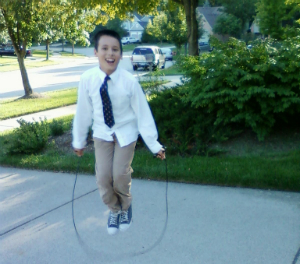
Parenting  At its heart, perfectionism is the need to control our circumstances, which is caused by underlying anxiety.
In the children’s book, The Girl Who Never Made Mistakes, the main character Beatrice overcomes her fear of public embarrassment and realizes that she enjoys doing things imperfectly with her friends and little brother.
It’s a wonderful story for children who are afraid to find out what would happen if they made a mistake or had an accident in public.
Anxiety is treatable. Three highly effective methods for treating anxiety are:
At its heart, perfectionism is the need to control our circumstances, which is caused by underlying anxiety.
In the children’s book, The Girl Who Never Made Mistakes, the main character Beatrice overcomes her fear of public embarrassment and realizes that she enjoys doing things imperfectly with her friends and little brother.
It’s a wonderful story for children who are afraid to find out what would happen if they made a mistake or had an accident in public.
Anxiety is treatable. Three highly effective methods for treating anxiety are:
 In The Perfectionist’s Handbook, author Jeff Szymanski recommends frequent breaks as a way for perfectionists to increase productivity and reduce stress.
I’ve noticed that breaks are most necessary when they seem most unattainable. A brisk walk around the block, a warm bath or a cup of hot chocolate are good options when the going gets tough.
In The Perfectionist’s Handbook, author Jeff Szymanski recommends frequent breaks as a way for perfectionists to increase productivity and reduce stress.
I’ve noticed that breaks are most necessary when they seem most unattainable. A brisk walk around the block, a warm bath or a cup of hot chocolate are good options when the going gets tough.
7 Ways To Help Your Child With Special Needs Overcome Perfectionism
A friend asked me, “How can I help a perfectionist whose physical skills or sensory issues limit his abilities to perform as he wishes?” Perfectionism is not a term usually associated with disabilities. But it can be a major obstacle to learning new developmental skills. It’s confusing and demoralizing to struggle at something while everyone else makes the same task look easy. Here are 7 ways to help your perfectionist conquer new territory.1. Acknowledge the pain
Learning to coordinate muscles to walk and talk is a physically and emotionally painful process. Validate those painful feelings and increase comfort whenever possible. Consider giving a massage in between exercises or playing favorite music. Offer something to look forward to and add some humor to the experience. Laughter is a natural anesthetic!2. Start with easy tasks
Somehow large tasks seem less daunting when the easy parts are finished first. Earlier today, my older son began to cry when he realized how much homework he had. He won’t settle for anything less than 100% complete and corrected assignments - a lofty goal for a person with his learning disabilities and memory impairments. He couldn’t concentrate on the long math problems, so I switched him over to his social studies book, where he only had to write the answer to one question. When that was done, I opened his science notebook, and he answered the two assigned questions. By then he had re-built his self-confidence and was ready to tackle the math. He went to bed right on schedule with a big smile.3. “Yard by yard is hard, inch by inch is a cinch”
Even the smallest steps move us forward to our goals. Not every day is for pushing limits; some days require a gentler touch. Two types of simple, short exercises that help with physical therapy, occupational therapy and cognitive goals are Brain Gym and Bal-A-Vis-X. Some of the Brain Gym exercises are similar to yoga poses, and most only take 1 or 2 minutes. The Bal-A-Vis-X exercises involve rhythmically bouncing or tossing bean bags and racquetballs between partners. Over time, these exercises do add up. My older son struggled for years to learn how to jump rope and had given up many times - and then one day, he did it.4. Treat anxiety
 At its heart, perfectionism is the need to control our circumstances, which is caused by underlying anxiety.
In the children’s book, The Girl Who Never Made Mistakes, the main character Beatrice overcomes her fear of public embarrassment and realizes that she enjoys doing things imperfectly with her friends and little brother.
It’s a wonderful story for children who are afraid to find out what would happen if they made a mistake or had an accident in public.
Anxiety is treatable. Three highly effective methods for treating anxiety are:
At its heart, perfectionism is the need to control our circumstances, which is caused by underlying anxiety.
In the children’s book, The Girl Who Never Made Mistakes, the main character Beatrice overcomes her fear of public embarrassment and realizes that she enjoys doing things imperfectly with her friends and little brother.
It’s a wonderful story for children who are afraid to find out what would happen if they made a mistake or had an accident in public.
Anxiety is treatable. Three highly effective methods for treating anxiety are:
- Positive visualization exercises - get started with a children’s book like Maureen Garth’s Starbright.
- Play therapy - read this Friendship Circle blog for ideas and resources.
- Cognitive-behavioral therapy - the book Your Anxious Child by Dacey and Fiore outlines this method clearly and concisely.
5. Take breaks
 In The Perfectionist’s Handbook, author Jeff Szymanski recommends frequent breaks as a way for perfectionists to increase productivity and reduce stress.
I’ve noticed that breaks are most necessary when they seem most unattainable. A brisk walk around the block, a warm bath or a cup of hot chocolate are good options when the going gets tough.
In The Perfectionist’s Handbook, author Jeff Szymanski recommends frequent breaks as a way for perfectionists to increase productivity and reduce stress.
I’ve noticed that breaks are most necessary when they seem most unattainable. A brisk walk around the block, a warm bath or a cup of hot chocolate are good options when the going gets tough.



